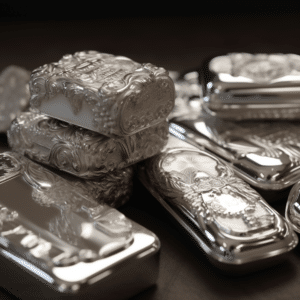As investors seek to diversify their portfolios, silver alternatives have emerged as an increasingly popular option.
From industrial applications to jewelry making, silver alternatives offer a range of benefits and drawbacks that are important for investors to understand.
This blog aims to provide a comprehensive overview of the various silver alternative investment options available in the market, as well as the factors that investors should consider when choosing between them.
If you want to invest as an expat or high-net-worth individual, which is what I specialize in, you can email me (advice@adamfayed.com) or use WhatsApp (+44-7393-450-837).
We don’t endorse any of the investments below. They are merely alternatives to silver.
What are the top five silver alternatives for investment?
There are several silver alternatives available in the market for investors who are looking to diversify their portfolios. Here are the top five silver alternatives for investment:
Palladium
This silvery-white metal is widely used in the automotive industry for catalytic converters and is also used in electronics, jewelry, and dentistry. It has gained popularity as an investment option due to its rarity and increasing demand.
Platinum
This dense, malleable metal is commonly used in catalytic converters, jewelry, and electronic components. As an investment, platinum is often seen as a hedge against inflation and a store of value, and its supply is relatively limited.
Rhodium
This rare and highly reflective metal is used primarily in catalytic converters and is also used in jewelry and electronic components. Due to its scarcity and increasing demand, rhodium has become a popular investment option in recent years.
Copper
This reddish-brown metal is widely used in construction, electronics, and plumbing and is often seen as a barometer of the global economy. As an investment, copper can be purchased in the form of futures contracts or exchange-traded funds (ETFs).
Nickel
This silvery-white metal is used primarily in stainless steel production and is also used in batteries, electronics, and magnets. As an investment, nickel can be purchased in the form of futures contracts or ETFs, and its value is closely tied to industrial demand.
Why might someone choose to invest in silver alternatives instead of traditional silver?
Investing in silver alternatives can offer several advantages over traditional silver investment options.
One of the main reasons that investors may choose to invest in silver alternatives is to diversify their portfolios.
While silver is a popular investment option, it can be subject to volatility and market fluctuations, and may not provide the level of diversification that some investors are seeking.
Silver alternatives, on the other hand, can offer exposure to different industries and markets, which can help to reduce overall portfolio risk.
In addition, some silver alternatives may have unique properties or use that make them more attractive to certain investors.
For example, palladium is widely used in the automotive industry for catalytic converters and is, therefore, more closely tied to global demand for cars and other vehicles.
Similarly, platinum is used in a wide range of industrial applications, including catalytic converters, electronic components, and jewelry, which can make it a more versatile investment option.
Another reason that investors may choose to invest in silver alternatives is to take advantage of potential market inefficiencies.
While traditional silver investments are widely traded and priced in the market, some silver alternatives may be less widely known or understood by investors, which can create opportunities for savvy investors to earn higher returns.

Platinum, a popular alternative to silver, is often seen as a hedge against inflation.
What are the benefits and drawbacks of investing in silver alternatives?
Investing in silver alternatives can offer several benefits and drawbacks, which investors should carefully consider before making any investment decisions.
Here are some of the key advantages of investing in silver alternatives:
- Diversification: Investing in silver alternatives can help to diversify a portfolio, as these metals may be less correlated with traditional asset classes like stocks and bonds.
- Potential for higher returns: Some silver alternatives may offer higher returns than traditional silver investments, as they may be less well-known or understood by investors.
- Unique properties or uses: Some silver alternatives have unique properties or use that make them more attractive to certain investors. For example, palladium is widely used in the automotive industry, while copper is used in construction and infrastructure projects.
- Potential for inflation hedging: Some silver alternatives, like platinum and palladium, may be used as a hedge against inflation.
On the other hand, here are the drawbacks of investing in silver alternatives:
- Price volatility: Like traditional silver investments, silver alternatives can be subject to price volatility and market fluctuations, which can create risks for investors.
- Market inefficiencies: Some silver alternatives may be less liquid or widely traded than traditional silver investments, which can create opportunities for higher returns but also carry greater risk.
- Industrial demand fluctuations: Some silver substitutes, such as palladium and platinum, are highly dependent on industrial demand, which is subject to changes due to geopolitical tensions and economic growth.
- Environmental concerns: Some silver alternatives, like nickel and copper, have environmental impacts that may concern socially responsible investors.
How do the prices of silver alternatives compare to traditional silver?
The prices of silver alternatives can vary widely, depending on a variety of factors, including supply and demand, industrial uses, and market trends.
In general, silver alternatives may be more or less expensive than traditional silver, depending on the specific metal and market conditions.
For example, as of April 2023, the price of palladium is significantly higher than the price of silver due to strong demand from the automotive industry and limited supply.
On the other hand, the price of copper is typically lower than the price of silver, as it is a more abundant metal with a wider range of industrial uses.
Platinum is another silver alternative that is commonly compared to traditional silver.
Historically, the price of platinum has been higher than the price of silver due in part to its scarcity and diverse industrial uses.
However, the prices of these metals can be subject to fluctuations based on a variety of factors, including economic conditions, geopolitical events, and global supply and demand.
What are some factors to consider when choosing silver alternatives for investment?
When choosing silver alternatives for investment, there are several factors that investors should consider to make informed investment decisions. Here are some key factors to consider:
Industrial demand
One important factor to consider is the level of industrial demand for the silver alternative in question. Some silver alternatives, such as palladium and platinum, are heavily dependent on industrial demand and may be more susceptible to price fluctuations based on changes in economic conditions.
Market liquidity
Investors should also consider the level of liquidity of the silver alternative they are considering. Some silver alternatives may be less liquid or widely traded than others, which can make it more difficult to buy or sell the metal at a fair market price.
Historical performance
Another important factor to consider is the historical performance of the silver alternative. This can help investors better understand the risks and rewards associated with investing in the metal.
Environmental concerns
Investors may also want to consider the environmental impact of the silver alternative they are considering. Some metals, such as copper, can have significant environmental impacts, which may be a concern for socially responsible investors.
Storage and transportation
Investors should also consider the logistics of storing and transporting the silver alternative. Some metals may require specialized storage or transportation arrangements, which can add additional costs and complexities to the investment.
Market trends and outlook
Finally, investors should carefully monitor market trends and economic conditions when considering silver alternative investments. Factors such as geopolitical tensions, inflation, and changes in supply and demand can all significantly impact the prices of silver alternatives and should be carefully considered before making any investment decisions.

Investors who are considering investing in silver alternatives should consult with a tax professional to better understand the specific tax implications of their investment.
Are there any tax implications to investing in silver alternatives?
Yes, there can be tax implications to investing in silver alternatives, and investors should be aware of these implications before making any investment decisions.
In general, gains from the sale of silver alternatives are subject to capital gains tax, which is calculated based on the difference between the purchase price and the sale price of the investment.
The rate of capital gains tax depends on a variety of factors, including the length of time that the investment was held and the investor’s tax bracket.
Additionally, some silver alternatives may be subject to special tax rules. For example, gains from the sale of palladium are subject to a higher capital gains tax rate than gains from the sale of other metals, due to its use in catalytic converters.
Similarly, gains from the sale of collectible coins made from silver or other metals may be subject to special tax rules.
Investors who are considering investing in silver alternatives should consult with a tax professional to better understand the specific tax implications of their investment, and to develop a tax strategy that helps to minimize tax liability and maximize potential returns.
Are silver alternative investments considered to be safe and stable?
Like any investment, silver alternative investments can carry risks and are not considered completely safe or stable.
However, the level of risk and stability associated with silver alternatives can vary depending on the specific metal and market conditions.
Some silver alternatives, such as palladium and platinum, may be subject to greater price volatility due to their heavy dependence on industrial demand.
Other silver alternatives, such as copper and nickel, may fluctuate based on economic conditions and geopolitical events.
However, silver alternative investments can also offer certain benefits that may help mitigate risks and increase stability.
For example, silver alternatives can offer diversification benefits by providing exposure to different industries and markets, which can help reduce overall portfolio risk.
Additionally, some silver alternatives, such as palladium and platinum, are widely used in industrial applications and may be less susceptible to market fluctuations than traditional silver investments, often seen as more speculative investments.
Ultimately, the level of risk and stability associated with silver alternative investments will depend on a variety of factors, including market conditions, supply and demand, and investor sentiment.
Investors should consider these factors carefully and consult with a financial advisor before making investment decisions.
What are some strategies for incorporating silver alternatives into a diversified investment portfolio?
Incorporating silver alternatives into a diversified investment portfolio can help to reduce overall portfolio risk and increase potential returns.
Here are some strategies for incorporating silver alternatives into a diversified investment portfolio:
- Determine your investment goals: Before investing in silver alternatives, it is important to determine your investment goals and risk tolerance. This can help you identify which silver alternative investments best suit your individual needs and goals.
- Consider the role of silver alternatives in your portfolio: Silver alternatives can play different roles in a portfolio, depending on the specific metal and investment strategy. For example, some silver alternatives may be used as a hedge against inflation, while others may be used to provide exposure to different markets and industries.
- Evaluate the risks and rewards: Each silver alternative investment carries its own unique risks and potential rewards. It is important to carefully evaluate these factors and consider how they fit into your overall investment strategy.
- Diversify across different silver alternatives: Just as it is important to diversify across different asset classes, it is also important to diversify across different silver alternatives. This can help to reduce overall portfolio risk and increase potential returns.
- Monitor market conditions: Silver alternative investments can be volatile. Monitoring market conditions and adjusting your investment strategy accordingly is essential.
- Consider professional advice: Investing in silver alternatives can be complex, and seeking professional advice from a financial advisor or investment expert may be beneficial.

The global shift towards electric vehicles will increase the demand for metals that are alternatives to silver.
What are some potential future trends and developments in the silver alternative investment market?
The silver alternative investment market is subject to a variety of trends and developments that can impact the prices and demand for different metals. Here are some potential future trends and developments in the silver alternative investment market:
- Increasing demand for electric vehicles: As the global shift towards electric vehicles continues, the demand for metals like lithium and cobalt, which are used in batteries, is likely to increase. This could create opportunities for investors in these metals.
- Growing interest in sustainable and ethical investing: Socially responsible investing is becoming more popular, and investors may increasingly seek out silver alternative investments that are considered environmentally and socially responsible.
- Advances in technology: New developments in technology, such as 3D printing, could create new opportunities for silver alternatives like titanium, which is used in 3D printing applications.
- Global economic conditions: Economic conditions, including inflation, geopolitical tensions, and shifts in global trade patterns, can impact the demand for silver alternatives
- Supply and demand imbalances: Like any commodity, imbalances between supply and demand can impact the prices of silver alternatives. For example, a palladium shortage due to increasing demand from the automotive industry could drive up prices.
- Changing regulations: Regulations related to the production and use of different metals can impact their prices and demand. For example, changes to emissions standards could impact the demand for palladium and platinum.
By monitoring these and other trends and developments, investors can stay informed about the silver alternative investment market and make more informed investment decisions.
Pained by financial indecision?

Adam is an internationally recognised author on financial matters with over 830million answer views on Quora, a widely sold book on Amazon, and a contributor on Forbes.



